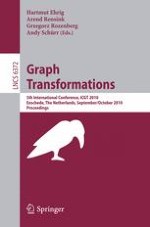Graphs are among the simplest and most universal models for a variety of s- tems, not just in computer science, but throughout engineering and the life sciences. When systems evolve we are interested in the way they change, to p- dict, support, or react to their evolution. Graph transformation combines the idea of graphs as a universal modelling paradigm with a rule-based approach to specify their evolution. The area is concerned with both the theory of graph transformation and their application to a variety of domains. The biannual International Conferences on Graph Transformation aim at bringingtogetherresearchersandpractitionersinterestedin the foundations and applicationsof graphtransformation.The ?fth conference,ICGT 2010,was held at the University of Twente (The Netherlands) in September/October 2010, alongwith severalsatellite events.It continuedthe line ofconferences previously held in Barcelona (Spain) in 2002, Rome (Italy) 2004, Natal (Brazil) in 2006 and Leicester (UK) in 2008, as well as a series of six International Workshops on Graph Transformation with Applications in Computer Science from 1978 to 1998. Also, ICGT alternates with the workshop series on Application of Graph Transformation with Industrial Relevance (AGTIVE). The conference was held under the auspices of EATCS and EASST.
